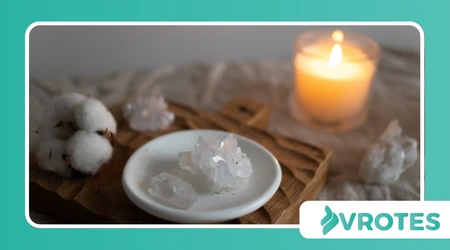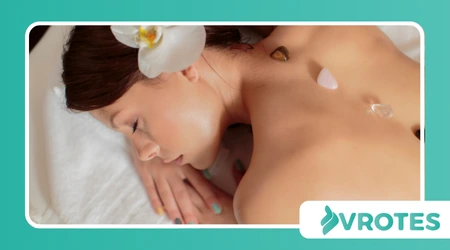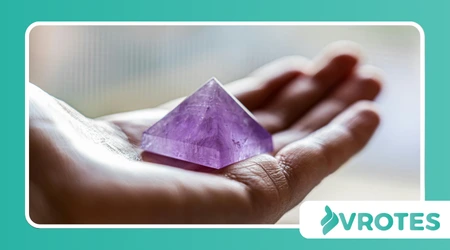Crystal Therapy for Emotional Well-Being in Menopause

Crystal therapy The journey through menopause is a profound transformation, often accompanied by a complex tapestry of emotional shifts.
Anúncios
While physical symptoms frequently take center stage, the inner landscape of a woman navigating this life stage demands equal, if not greater, attention.
Embracing holistic approaches, such as crystal therapy, can offer remarkable support for emotional well-being during this pivotal time.
It’s about finding balance when the body recalibrates its natural rhythm.
Menopause is more than just a biological event; it’s a profound transition, akin to a spiritual awakening for many.
Anúncios
The hormonal fluctuations of perimenopause and menopause can trigger a cascade of feelings. From irritability to unexpected bouts of sadness, the emotional rollercoaster can feel relentless.
Many women report experiencing heightened anxiety. Some also wrestle with newfound feelings of unease.
The mind and body are intricately connected, and this truth becomes strikingly clear during menopause. When one aspect is out of balance, the other often follows suit.
Holistic modalities recognize this intrinsic link. They aim to nurture the entire being. This integrated approach fosters resilience.
For centuries, various cultures have revered crystals for their purported energetic properties. They believed these natural formations held unique vibrations.
These vibrations could interact with our own energy fields. This ancient wisdom suggests a profound connection.
Understanding the Energetic Landscape of Menopause
Menopause can feel like an energetic restructuring. The body is literally re-patterning itself. This process, while natural, can be destabilizing.
Energy centers, or chakras, may feel out of sync. This can lead to emotional discord.
Think of it like an orchestra tuning its instruments. Each instrument, representing a different bodily system, is adjusting.
Until they find harmony, there can be dissonance. Crystal energies can act as a gentle conductor. They help guide this internal orchestration.
Read more: Forest Bathing: Natural Stress Relief for Hormonal Imbalance
Emotional well-being is not merely the absence of negative feelings. It’s the presence of inner peace and resilience.
During menopause, cultivating this inner sanctuary is paramount. It allows women to navigate changes with grace.
The Gentle Embrace of Crystals: How They Support Emotional Balance
Crystal therapy operates on the principle that crystals emit stable energetic frequencies. These frequencies can help harmonize our own vibrational fields.
They act as energetic tuning forks. This interaction is believed to promote balance.
When placed on or near the body, crystals may help to calm the nervous system. They can also soothe emotional agitation.
Their subtle energies are thought to promote a sense of grounding. This can be especially beneficial during times of upheaval.
Consider the analogy of a noisy room. If you introduce a calming sound, like soft music, the overall atmosphere shifts.
Crystals are believed to do something similar. They introduce a resonant frequency that encourages equilibrium.
The selection of specific crystals often depends on the emotional challenge. For instance, some crystals are known for their calming properties.
Others are associated with self-love and confidence. The choice is often intuitive.

Crystals for Specific Emotional Challenges During Menopause
Various crystals are traditionally associated with different emotional states, offering targeted support.
For Anxiety and Stress: Amethyst and Lepidolite
Amethyst, with its beautiful purple hues, is renowned for its calming energy. It’s often used to alleviate anxiety. Many find it promotes peaceful sleep. Its serene vibration encourages relaxation.
Lepidolite, a lilac-gray mica mineral, contains lithium. This element is often found in mood-stabilizing medications.
Lepidolite is believed to soothe emotional extremes. It promotes tranquility and reduces stress. Keeping these near can offer comfort.
For Irritability and Frustration: Rose Quartz and Blue Lace Agate
Rose Quartz, the stone of unconditional love, helps open the heart chakra. It promotes self-love and compassion.
This can be incredibly beneficial when irritability arises. It fosters gentleness toward oneself and others.
Check this out: Aromatherapy Blends to Reduce Menopause-Related Stress
Blue Lace Agate is known for its calming and soothing properties.
It encourages clear communication. This can help diffuse feelings of frustration. Its gentle energy promotes peace. It aids in self-expression.
For Sadness and Mood Swings: Citrine and Sunstone
Citrine, a warm and radiant crystal, is often called the “stone of joy.” It’s believed to uplift spirits. It can help dispel negative emotions. This vibrant stone encourages optimism.
Sunstone, with its fiery inclusions, embodies vitality and warmth. It’s associated with personal power and good fortune.
It can help counteract feelings of sadness. It encourages enthusiasm and independence.
For Low Self-Esteem and Lack of Confidence: Carnelian and Garnet
Carnelian, a vibrant orange stone, is known for boosting courage. It enhances creativity and vitality.
It can help rekindle a sense of purpose. This crystal encourages embracing change.
Garnet, with its deep red hues, is a stone of passion and energy. It’s believed to strengthen self-confidence. It fosters a sense of security. It can help women reclaim their power.
Incorporating Crystals into Daily Life
Integrating crystals into your daily routine doesn’t require elaborate rituals. Simple practices can yield profound benefits.
- Meditation: Hold a chosen crystal during meditation. Focus on its energy and your intention. This deepens the meditative experience.
- Placement: Place crystals in your living spaces. Bedrooms, offices, or meditation altars are ideal. Their energy subtly influences the environment.
- Wearing: Wear crystal jewelry, like pendants or bracelets. This keeps their energy close to your body throughout the day.
- Elixirs (Indirect Method): Some create crystal elixirs by placing cleansed crystals around a glass of water, allowing the water to absorb their energetic imprints (never put crystals directly in water unless certain they are safe and non-toxic).
It’s crucial to cleanse and charge your crystals regularly. This maintains their energetic vibrancy.
Methods include moonlight baths, smudging, or placing them on selenite. This ensures they remain potent tools.

A Deeper Look: The Placebo Effect and Personal Experience
While scientific research on crystal therapy is still evolving, the subjective experience of many users speaks volumes.
The power of belief and intention, often termed the placebo effect, plays a significant role in any holistic healing modality.
++ Coping Strategies for Menopause-Induced Mood Swings
If a woman believes a crystal is helping her, that belief itself can be transformative. This is not to diminish the potential energetic properties of crystals.
Instead, it highlights the intricate interplay between mind, body, and belief.
A compelling example of the mind’s power comes from a 2018 study published in the Journal of Pain.
This research demonstrated that even a “placebo” analgesic could significantly reduce pain perception in participants.
This underscores the profound impact of expectation and belief on our physical and emotional states. While not directly about crystals, it illustrates the mind’s capacity for self-healing when engaged with a chosen modality.
Furthermore, consider the ritualistic aspect of using crystals. The act of selecting a stone, holding it, and setting an intention creates a moment of mindfulness.
This deliberate focus on well-being can be a powerful antidote to the often-overwhelming feelings of menopause. It provides a tangible anchor for positive intention.
Empowering Your Menopausal Journey
The journey through menopause is deeply personal. It presents an opportunity for profound self-discovery.
Crystal therapy offers a gentle, non-invasive avenue for emotional support. It can empower women to navigate this phase with greater ease.
Choosing to explore holistic methods like this means embracing a proactive role in your well-being.
It’s about listening to your body’s wisdom. It’s about seeking tools that resonate with your spirit. Every woman deserves to feel balanced and empowered.
| Emotional Challenge | Recommended Crystals | Key Energetic Property |
| Anxiety/Stress | Amethyst, Lepidolite | Calming, Soothing |
| Irritability | Rose Quartz, Blue Lace Agate | Love, Communication, Peace |
| Sadness/Mood Swings | Citrine, Sunstone | Joy, Uplifting, Vitality |
| Low Self-Esteem | Carnelian, Garnet | Courage, Confidence, Grounding |
This holistic path acknowledges the unique needs of women in menopause. It offers a gentle embrace, providing comfort and stability.
Will you allow yourself the grace of these ancient allies?
Frequently Asked Questions
Q: Are there any scientific studies proving crystal therapy works?
While specific clinical trials on crystal therapy are limited, many people report subjective improvements in emotional well-being.
The benefits are often experiential and deeply personal.
Research into the subtle energy fields of the human body and natural materials is an emerging field, and continued exploration may shed more light on these interactions.
Q: How do I choose the right crystal for me?
Often, the best way to choose a crystal is by trusting your intuition. Hold different crystals and see which ones you feel drawn to.
You might notice a warming sensation, a sense of calm, or simply a visual appeal.
Researching the properties of various crystals can also guide your selection based on your specific emotional needs.
Q: How often should I cleanse my crystals?
The frequency of cleansing depends on how often you use your crystals and for what purpose. If you’re using them daily for intense emotional work, weekly cleansing might be beneficial.
For general use, monthly cleansing is often sufficient. Trust your intuition – if a crystal feels “heavy” or less vibrant, it’s probably time for a cleanse.
Q: Can crystals replace conventional medical treatment for menopause symptoms?
No, crystal therapy is a complementary approach and should not replace conventional medical advice or treatments for menopause symptoms.
It can be a wonderful tool for supporting emotional well-being, but always consult with your healthcare provider for medical concerns.
Crystals work best as part of a comprehensive wellness strategy.
Q: Are all crystals safe to handle?
Most commonly used crystals are safe to handle. However, some crystals can be toxic if ingested or if their dust is inhaled.
Always research a crystal before using it, especially if you plan to make elixirs or place them directly on your skin for extended periods.
When in doubt, use an indirect method or simply place the crystal near you.
